9
Articulating an Old-Middle-Class Ideology: 1904-1905
Late in 1904 the Edison Manufacturing Company began to produce films closely tied to trends in American popular and mass culture, but they seldom followed in the immediate paths of rivals. This commitment to the risks and rewards of producing original narrative "features" coincided with the hiring of William J. Gilroy in late October. Gilroy, who had worked intermittently for the Kinetograph Department since at least September 1902, served as Porter's trusted assistant and received $15 per week.[1] In mid January 1905, moreover, the Kinetograph Department hired Robert K. Bonine, who had worked for Edison in the late 1890s and then for Biograph in the early 1900s. Replacing Jacob B. Smith, who had left two weeks earlier, he received $35 per week—the same salary as Porter. While Bonine was in charge of the Edison film development facilities at the Orange Laboratory, he took a significant number of actualities during the two and a half years of his Edison employment, beginning with President Roosevelt's Inauguration on March 4th.
The Edison staff was further strengthened by a talent raid on the Biograph Company. A. E. Weed, an experienced Biograph cameraman, and Wallace McCutcheon, the Biograph production chief, joined Edison in mid May. Weed, probably a replacement for A. C. Abadie, was paid $18 per week. Drills and Exercises —Schoolship "St. Mary's, " shot on May 31st, was his first official production. Hiring Wallace McCutcheon, the producer of Personal and other Biograph hits, was a major coup. McCutcheon perhaps expected to start another production unit for fiction films, but he found himself acting as Porter's chief collaborator. Since the new co-producer/co-director garnered a $40 per week salary, Porter's income had to be raised to the same figure. Both men
received the same pay for the next two years—suggesting the equality of their professional relationship. (How these two leading American filmmakers collaborated will be considered in the following chapter.) This talent raid both hurt Biograph and helped Edison. The revitalization of production did not wait for McCutcheon's arrival, however, but began with The Ex-Convict (November 1904). In the six months until McCutcheon's arrival, actor Will Rising may have worked most closely with Porter.
American Themes and Values: Family and Society
Historians since Terry Ramsaye have remarked on Porter's articulation of social problems in The Ex-Convict and The Kleptomaniac (January 1905).[2] These two features were part of a larger group of films, made between November 1904 and December 1905, that directly and indirectly confronted significant social issues in American life. Despite a shift away from actualities, Porter continued to conceive of cinema as a form that could inform and instruct as well as entertain. His films were still linked, albeit less directly, to the concept of a visual newspaper, for he focused on problems raised in the antitrust editorials and political cartoons of the New York Journal-American and the New York World . These pictures, which represented one of several ideological positions evident in American popular and mass culture, were the most ambitious cinematic expressions from this period.
Although several Porter/Edison films, if viewed separately, are ideologically consistent with then emerging trends of Progressive thought, as a body of work they express the often contradictory worldview of the old middle class and small-town America confronted with an era of large-scale manufacturing and monopoly capital.[3] In short, these films remained consistent with Porter's own experience of America while growing up in Connellsville, Pennsylvania, and with a viewpoint expressed twenty years earlier in his hometown newspaper, The Keystone Courier .
The Ex-Convict , advertised as "a beautiful pathetic story in Eight scenes,"[4] quickly and simply depicts a former criminal who is forced to return to a life of crime because he cannot escape the stigma of his past. A member of the working class, he is sympathetically portrayed as a good family man driven to despair by the plight of his sick child. Dismissed from his job because of his past, the ex-convict cannot find work and is soon forced to return to a life of crime. He tries to rob a wealthy home but is caught and seems certain to return to prison—a development that will completely destroy his family. Instead, it turns out that his captor is the father of a girl whom he has recently saved in an earlier scene. When the daughter appears and is reunited with her saviour, the father relents and sends the police away. In the final scene, the rich man befriends the ex-convict, bringing food and presents to his garret apartment.
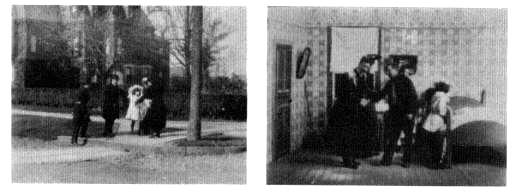
A young girl is embraced by her wealthy family after the ex-convict has rescued her from an
onrushing automobile. Later, the fathers shake hands when they visit the poor man's home.
This film was based on a vaudeville one-act, Number 973 , by Robert Hilliard and Edwin Holland. It previewed at Keith's Union Square Theater on March 27, 1903, and was enthusiastically received (see document no. 16). When the play-let, which Hilliard and Holland also co-directed, headed a bill at the same theater on August 31st, the Dramatic Mirror felt that
the piece is strong, concise and well-written and the situations are dramatic without being overdrawn. Mr. Hilliard did excellent work as the rough malefactor with the right sort of heart, and his scene with the little girl was played with much delicacy and feeling. Mr. Holland as the District-Attorney was dignified and forcible, and little Jane Pelton as the child was very sweet indeed. The setting and light effects were admirable in every way.[5]
Hilliard, once a leading actor in the legitimate theater, was an established vaudeville star of the first magnitude. The one-act thus generated unusual attention. A short review in the New York World remarked that the "pathetic little playlet . . . stirred a deeper feeling than vaudeville sketches usually allow."[6] A critic with a sharp memory, however, noted that the Hilliard-Holland script was itself heavily indebted to the play Editha's Burglar .[7] Like Hilliard, Porter was reworking a well-known story.
Starting from the Hilliard-Holland playlet, Porter visualized the information into seven additional scenes. Unlike Uncle Tom's Cabin or Parsifal, The Ex-Convict was not filmed theater, but an adaptation that took advantage of the filmmaker's ability to place a scene in an appropriate location (outside a store, home, or factory and on the street) and to move quickly from one setting to the next. The naturalistic locales and the accelerated pace heightened the emotional intensity of the viewer's reaction to the pathetic story, achieving a level of re-
alism impossible on the stage. Titles at the beginning of each shot in some cases provided lines of dialogue spoken by the character within the scene. In the process of adaptation, Porter also added an important new element: the ex-convict's family. This reflected Porter's own preoccupations and made the film more complex.
The Ex-Convict thus represents a major breakthrough in stage-to-screen adaptation. First, it opened up the play, situating the action in many more locations. Second, it reworked and altered the story itself, making it the filmmaker's own. These creative moves soon became standard practice in American cinema. Examples in silent film include Porter's The Miller's Daughter (1905) and The Prisoner of Zenda (1913), Cecil B. DeMille's Male and Female (1919), and Griffith's Way Down East (1920) and Orphans of the Storm (1921), but they continue to this day.
DOCUMENT NO . 16 |
HILLIARD TRIES A NEW PLAY |
The admirers of Robert Hilliard had a chance on Friday afternoon to see him in two widely different characters. At half-past two he appeared as the debonair van Bibber in The Littlest Girl and at four o'clock he showed that he could be just as effective in shabbier make-up as the principal person in a new one-act play called Number 973, written by himself and Edwin Holland. The scene of the sketch is laid in the home of Thomas Campbell, District Attorney of New York. Thither comes a burglar who is caught in the act by the District-Attorney who recognized in him the man he had sent up some ten years before for alleged manslaughter. The lawyer promptly telephones for the police, and while he is waiting listens to the burglar's interesting story. Later during the temporary absence of the lawyer the little daughter of the house appears. She had a narrow escape from death the day before under the hoofs of a runaway horse and, it transpires that the man who had saved her was none other than the burglar, who had been driven to his rash act by starvation. The father overhears the conversation between his child and the unfortunate fellow and when the police come in he dismisses them. The inference is that he will not prosecute the preserver of his baby, and the curtain falls on a very pretty picture. The piece made a decided hit at this trial performance and Mr. Hilliard made a neat little speech, expressing his thanks at its very cordial reception. The play is decidedly more effective for the average audience than The Littlest Girl and is a welcome addition to Mr. Hilliard's repertoire. |
SOURCE : New York Dramatic Mirror , April 4, 1903, p. 18. |
The Ex-Convict focuses on two central institutions whose structures and values concerned Porter throughout his career—family and society. In his many family-centered dramas, parents are constantly threatened with the loss of a child through sickness, fire, or some bizarre act of nature. Again and again they are driven to despair and either through some bold act (the fireman's daring rescue in Life of an American Fireman or the father's battle with a bird in Rescued from an Eagle's Nest ) or simply good fortune, the child is saved and the family reunited. As mentioned in chapter 2, child-centered dramas were not rare in turn-of-the-century America, but Porter's own films reveal an emotional urgency and personal preoccupation that reflected his own loss of progeny. Although the family was often romanticized in American culture of this period, Porter's systematic idealizations reveal a longing for a way of life he found increasingly unattainable. The loss of the child is his own loss.
The Ex-Convict places family and society in conflict, but family values are given primacy. The love and intimacy within the ex-convict's and wealthy attorney's families are contrasted to the impersonality, selfishness, and class antagonism of the social system. The ex-convict is forced to break the law in an attempt to save his daughter's life because society, controlled by the rich, fails to protect its more vulnerable members. The ex-convict's desperate decision to steal is viewed sympathetically, if not actually condoned. When the ex-convict is finally caught, it appears that his family will be destroyed and his child allowed to die once he goes to jail. Family ties become a mechanism for reconciling class differences. If the rich man can forgive the would-be burglar because the ex-convict's daring rescue saved his daughter's life, he can empathize with the poor man's plight because the attempted burglary was motivated by his own child's sickness. In Uncle Tom's Cabin , the death of Eva precipitates the destruction of the family, and the selling of Uncle Tom foreshadows America's internal strife, culminating in the Civil War. The Ex-Convict presents a parallel situation, in which class rather than racial antagonisms are on the verge of spinning out of control. Here, both children (childhood representing innocence and hope for the future) are saved by the good works of the opposing classes and a last-minute reconciliation becomes possible.
In the United States, where Social Darwinism was widespread, Progressives argued that the working class was being forced into a state of destitution and "the great middle class" into one of dependency and genteel poverty. In expressing a longing for a world with greater social justice, for the reduction of class conflict and for a heightened consciousness of the well-to-do vis-à-vis the real grievances of the working class, The Ex-Convict articulated a central concern of the Progressive movement.[8] During the year Porter made this film, Robert Hunter, a journalist of Progressive persuasion, examined the plight of family men in situations similar to the ex-convict's. "The mass of working men on the brink of poverty hate charity," he wrote. "Not only their words convey a
knowledge of this fact, but their actions, when in distress, make it absolutely undeniable. When the poor face the necessity of becoming paupers, when they must apply for charity if they are to live at all, many desert their family and enter the ranks of vagrancy; others drink themselves insensible; some go insane; and still others commit suicide."[9] As Porter's film points out, they might also turn to crime.
The state plays a key, if peripheral, role in The Ex-Convict . One of its representatives, a policeman, undermines the ex-convict's honest, modest, and happy way of life by informing his employer of his past. Another patrolman engages the rich child's nurse (whose nurturing role is the female counterpart of the policeman's) in conversation, causing (or failing to prevent) an accident that would have killed the child if the ex-convict had not intervened. In each instance, the policeman is not intentionally bad—he is merely warning the employer or flirting with the nurse. The consequences of their actions are nonetheless catastrophic, and in both cases it is the ex-convict who suffers. Porter suggests that the state must be more thoughtful and aware of its responsibilities. Its actions (or its failure to act) have consequences in modern society, which is faced with new technology (the automobile that almost runs over the child) and impersonal class relations (the warehouse owner who fires his employee, presumably because he has no personal relationship with him and cannot vouch for his character).
The Ex-Convict was not the first film to deal with class conflict and idealize a reconciliation of labor and capital. In Pathé's The Strike , produced in the summer of 1904, a walkout leads to violence and the deaths of a worker and the factory owner. Eventually the owner's son, who had sided with the workers, and the dead worker's wife, who killed the owner in a moment of rage, reconcile their differences. The film ends "in an apotheosis [where] Labor as a Workingman and Capital as a Rich Man, unite their power to give happiness and fortune to every man. Justice appears and ratifies this alliance."[10] It is quite possible that a viewing of this and similar European imports encouraged Porter to raise social concerns in his films. Despite many parallels between the Edison and Pathé films, Porter chose to situate the conflict between labor and capital not within the work place but within the home. He tended to foreground the social rather than the economic dimensions of the conflict.
The Kleptomaniac , which Porter photographed in the second half of January 1905, continued to explore the themes examined in The Ex-Convict . Condemning the class bias of government and justice, it is Porter's most radical film. The details given in the Edison catalog are not always evident when the film is viewed silently—for instance, there is no reason to suppose the kleptomaniac is a banker's wife (see document no. 17). Many of the specifics, however, could have been articulated in a showman's lecture. Reliance on the exhibitor's
mediation is also suggested by Porter's camera framing and composition. As William Everson has observed, "the interior shot of the department store is so 'busy,' with so many identically dressed women bustling around in a protracted long shot, that the audience is given no guidance at all as to where to look or what is going on."[11] The exhibitor could relieve some of this confusion, perhaps basing his lecture on the catalog description. In this particular scene, a commentator might have reminded viewers that their frustrating efforts to detect the kleptomaniac were not unlike the task of the store detective (recalling the viewer identification with passengers in The Great Train Robbery ).
DOCUMENT NO . 17 | |
THE KLEPTOMANIAC | |
Two Acts—Ten Scenes and Tableau. | |
The Kleptomaniac (Mrs. Banker) | Miss. Aline Boyd |
Store Detective | Mr. Phineas Nairs |
Female Detective | Miss. Jane Stewart |
Superintendent Department Store | Mr. George Voijere |
The Thief | Miss. Ann Egleston |
Police Court Judge | Mr. W. S. Rising |
Justice | Miss. Helen Courtney |
Shoppers, Salesladies, Cash Girls, Policemen, Prisoners | |
ACT I. | |
Scene I.—Leaving Home. | |
The opening scene shows a beautiful residence in a fashionable residential section of New York city. A handsome and richly gowned lady is descending the steps, while a stylish victoria, with coachman and footman in full livery, is waiting at the door. She enters the carriage, gives the footman his orders and drives off. All the surroundings indicate wealth and fashion. Mrs. Banker is going on a shopping tour. | |
Scene II.—Arrival at Department Store. | |
The next scene shows a well-known department store at Herald Square, New York city. A stylish turnout is coming down Broadway and stops in front of the main entrance. The footman jumps from the box and Mrs. Banker alights and enters the store. | |
Scene III.—Interior Department Store. | |
The interior of the department store is shown. Shoppers are busily engaged making purchases at the different counters. Cash girls are running about in all directions and a floor walker is busy giving orders and directing and attending to the wants of customers. Presently Mrs. Banker is seen approaching the hosiery counter. The saleslady waits on her and | |
(Text box continued on next page)
shows her the different styles, but none appear to suit her. While the saleslady's back is turned for a moment, Mrs. Banker quickly conceals a pair of hose in her muff and then passes on to the glove counter. In the meantime, her actions have excited the suspicion of a female detective, who now shadows her from counter to counter. At the glove counter she purchases some gloves and orders them sent home, and at a favorable moment adroitly slips a pair into her muff. The lynx-eyed female detective, however, has detected her in the act, informs the floor walkers, and then leaves to find the store detective, and both soon return to the scene. Mrs. Banker is now at the silverware counter, closely watched by the detective. To distract the clerk's attention she requests to be shown some article in a rear case, and while the clerk's back is turned she seizes the opportunity to take a silver flask from the counter and secrete it in her muff. As she turns to go the female detective steps up and accuses her of the theft, which she indignantly denies. The store detective now approaches and conducts Mrs. Banker away through a throng of curious shoppers, who have been attracted by the excitement and commotion. |
Scene IV.—Superintendent's Office. |
The scene shows the interior of the superintendent's office. He is occupied at his desk while the stenographer is transcribing on the typewriter. The female detective enters and explains the situation. Presently Mrs. Banker enters accompanied by the store detective. The female detective boldly accuses her of shoplifting. Mrs. Banker , in a most haughty manner, denies the charge, whereupon the female detective quickly snatches her muff and withdraws the stolen articles. Mrs. Banker then breaks down and confesses and pleads for mercy. The superintendent is deaf to her entreaties, and the store detective leads her away. |
Scene V.—Under Arrest. |
The scene now returns to the exterior of the store. The carriage is still waiting. Mrs. Banker and the detective enter the carriage and drive away. |
Scene VI.—Police Station. |
The exterior of the police station house is shown. A carriage drives up to the door, and the occupants alight and enter the building. We recognize Mrs. Banker and the store detective. |
ACT II |
Scene I.—The Home of Poverty. |
A scantily furnished room. Poverty and hunger are plainly in evidence. A poor woman is seated at a table with her face buried in her hands. Her youngest child is seated on the floor crying with hunger. Presently a young girl enters. She is evidently the older daughter, who has been out begging |
(Text box continued on next page)
in the streets but has returned empty-handed. In desperation the mother throws a shawl over her head and rushes from the room. |
Scene II.—The Thief. |
A street scene. An errand boy is coming out of a grocery store with a basket on his arm. The proprietor rushes out and sends him back to the store for some things he has forgotten. The boy leaves his basket at the door and goes back into the store. At this moment a poor woman comes along, takes a loaf of bread from the basket and hides it under her shawl. The proprietor, who has watched her, rushes out, seizes her and calls for the police. An officer soon appears and drags the woman off to the patrol wagon. |
Scene III.—In the Police Patrol. |
The scene shows the exterior of a police station house. A patrol wagon is being rapidly driven up the street and stops in front of the station house in the middle of the street. The snow is piled high up on both sides, making it impossible to drive up to the sidewalk. A poor woman is taken from the wagon by an officer and led into the station house. |
Scene IV.—Police Court. |
A court room seat. The judge enters and takes his seat. He raps for order and opens the court. Among the motley crowd of prisoners the judge discerns Mrs. Banker . He calls a court attendant and instructs him to give Mrs. Banker a chair away from the other prisoners. The clerk then proceeds to call the case. |
The first prisoner before the bar is a tough. His blackened eye and battered condition tell their own story. He is quickly sentenced. Vagrancy and larceny cases follow and no time is lost in disposing of them. The next case is one of disorderly conduct. A flashily dressed woman appears and tries to flirt with the judge. She is quickly given an extra sentence "on the island" for her impertinence, and as she is led away by the officer she raises her foot and dress and waves ta-ta to the judge. |
The next case is petty larceny. We recognize the poor woman in the two preceding scenes. The officer who arrested her, as well as the groceryman, appear against her. She pleads for mercy. Her little daughter rushes to her side and falls on her knees and pleads to the judge for her mother. But the judge is deaf to all entreaties, and the poor woman is sentenced and led away. |
The next case is shoplifting. Mrs. Banker is led to the bar. Her husband, accompanied by a lawyer appears in her defense. The female detective gives her evidence, but the judge ignores her testimony and discharges the prisoner, who falls weeping into her husband's arms. |
(Text box continued on next page)
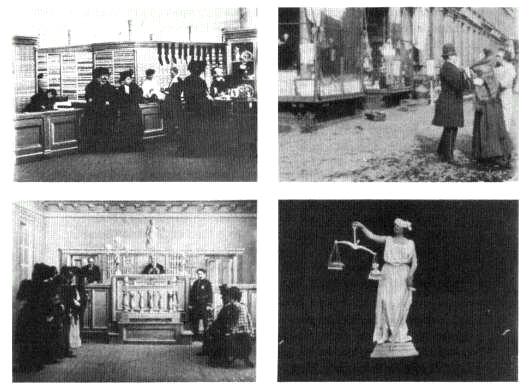
The Kleptomaniac. Mrs. Banker goes on a carefully planned shoplifting spree at Macy's; the desperate
mother spontaneously steals bread for her children. The courtroom, where, as the final tableau suggests,
justice favors the wealthy.
Tableau—Justice |
A tableau of the figure of Justice. On one side of the scale is a bag of gold, and on the other a loaf of bread. The balance shows in favor of the gold. The bandage on the brow of Justice, however, discloses one eye. Fully described and illustrated in Circular No. 233. 670 ft. |
SOURCE : Edison Films , July 1906, pp. 55-56. |
In The Kleptomaniac Porter juxtaposes the situations of two women.[12] The impoverished woman is shown at home, in the context of her family. Important details are shown that elicit the viewer's understanding and sympathy: the barren room, the absence of a husband/provider, and the weighty responsibility of children who need care and are still too young to work. Mrs. Banker is never shown inside her home, although the brownstone from which she emerges
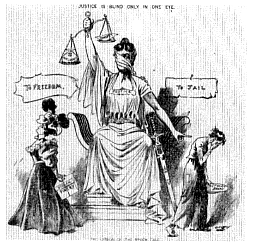
An editorial cartoon on the front
page of the New York World.
clearly indicates her social status. Porter denies her the sympathetic context of family life. She, as the title indicates, has no motivation for shoplifting other than the thrill. Mrs. Banker goes inside a high-class emporium (Macy's) and steals some expensive, nonessential baubles under the noses of sales personnel. Her actions are clearly premeditated. The poor woman is overwhelmed by temptation, stealing food left outside and unattended. Her actions are spontaneous. Although she left home determined to help her family, her specific actions are far from certain. Finally, once arrested, the wealthy kleptomaniac is treated with a courtesy and leniency denied the more deserving mother.
The media during this era frequently criticized and visualized the inequities of a judicial system that favored the rich and lacked understanding for the circumstances of the poor. In June 1896 the New York World ran a front-page political cartoon that anticipated Porter's closing tableau in The Kleptomaniac in all its details.[13] Similar examples of this iconography were undoubtedly produced during the intervening nine years. Porter offered exhibitors the opportunity of extending this criticism still further by identifying the kleptomaniac with the banks. The depiction of Mrs. Banker stealing in Macy's reflected indirectly on her husband, suggesting that he stole as well, but on a grander scale and with the same tacit support and "understanding" of the government. The banking community, which played a key role in the emergence of monopoly capital and the trusts, was frequently attacked by the Progressive movement, which held it responsible for reducing members of the middle and working classes to impoverishment. Thus the poor woman steals to alleviate her family's destitution, which Mr. Banker's accumulation of wealth had helped to create. On this level,
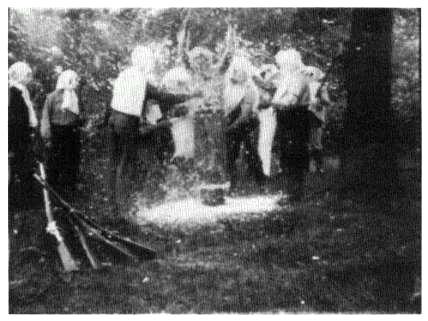
The "White Caps." Rural justice may be harsh, but it is the guilty who are punished.
the simple dualism of rich and poor approaches a more profound, more dialectical relationship between the two central figures.
In The Ex-Convict and The Kleptomaniac , the impoverished parents' crimes are motivated by the needs of their children and are not condemned. Rather, a socioeconomic system in which two essential social values—familial responsibility and honesty—are in conflict is itself in need of reevaluation. The Kleptomaniac , however, does not have the requisite happy ending evident in The Ex-Convict . The personal interaction that makes this possible in the former film is absent in the latter.
Edison's The "White Caps " (August 1905) looks at a troubled nuclear family and the community's eventual intervention in its problems outside the established channels of justice. In 1905 White Cap vigilante groups were active in rural areas of the border states and the Midwest. Members, generally faced with declining income and political power, acted as agents of social control, punishing offenses that the state and local governments failed to address adequately. In this Porter/McCutcheon production, a husband comes home drunk and beats his wife and daughter. To punish him, relatives and neighbors of the beaten woman form a squad of white-hooded vigilantes. After a struggle, the drunkard is tarred, feathered, and drummed out of town on a rail. The film offers a view
of small-town America in which a wayward member is taught a lesson without the formalities of a legal system.[14] The rural community acts as an extension of the family.
A pro-vigilante view of these events was offered in Edison advertisements:
During the rapid march of civilization in America, covering the past fifty years, certain social conditions developed which had to be regulated and controlled by unusual methods. A lawless and criminal element almost invariably accompanied the advance guard of civilization and to keep this element in check the law abiding citizens were compelled to secretly organize themselves for their own protection.
The "Vigilantes" during the gold excitement of '49 in California and the "White Caps" of more recent years in Ohio, Indiana, and other Western States, are well-known organizations which dealt summarily with outlaws and the criminal classes in general.
We have portrayed in Motion Pictures, in a most vivid and realistic manner, the method employed by the "White Caps" to rid the community of undesirable citizens.[15]
The Progressive perception of corrupt justice in The Kleptomaniac could be easily perverted in a different setting, particularly in a rural one.
The "White Caps " had at least two theatrical antecedents. The first was Owen Davis's play The White Caps , which appeared in various cities a few months before the Porter film was made.[16] Despite the similarity in name, however, their narratives had little in common. Rather the tone and narrative of the Porter film owed more to Thomas Dixon, Jr.'s adaptation of The Clansman , which the playwright was rehearsing—amidst considerable publicity—as The "White Caps " went into production.[17] In The Clansman , villainous blacks are sponsored by corrupt carpetbaggers, while the Klan is presented as a force for regeneration. If the Edison film avoids the overt racism of Dixon's novel, it depicts and even accepts a pattern of alternative justice that supports it.
The methods used to influence spectators in The "White Caps " can be compared to Griffith's approach in The Birth of a Nation , which was based on The Clansman . Porter assumed that the viewers' moral outrage at the husband's behavior would lead them to condemn the drunkard and condone his punishment. (In fact, the brutal treatment of the husband usually leads present-day audiences to recoil from his fate.) Griffith, anxious to convert people to his beliefs in white supremacy, did not assume shared attitudes and effectively used parallel editing to force his audience into identifying with the Klan. The Edison film maintains a psychological distance from its subject matter, not because Porter attempted to be objective but because he relied on the audiences' pre-established attitudes to elicit their reactions.
Family was also a subject that Porter addressed in his comedies. The Strenuous Life; or, Anti-Race Suicide (December 1904), lightheartedly spoofs family life and fatherhood. President Roosevelt, who had just won reelection, believed Americans had to lead "the strenuous life" (it was the title of one of his books)
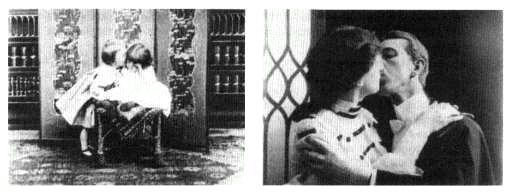
The Seven Ages: William Shakespeare via The May Irwin Kiss.
if the United States was to retain its position of world leadership. He also declared that married women of northern European stock had a responsibility to produce at least four children to prevent "race suicide."[18] Porter combined and burlesqued these two elements: the father returns home as his wife gives birth and soon finds himself caring for quadruplets. The father's expression of pride as he weighs the first baby motivated Porter to cut in to a close shot of his face. (By late 1904, the interpolated close-up of a character's face had been used in well-known films like Biograph's The Lost Child and G. A. Smith's Mary Jane's Mishaps. The Strenuous Life signaled its entry into Porter's repertoire of cinematic strategies.) The father's expression quickly changes to distress as one infant after another is brought in by the nurse. Roosevelt's stock phrases are lampooned in a manner that recalls Terrible Teddy, the Grizzly King (1901).
The centrality of family can also be seen in Porter's treatment of romance and sexuality. In The Seven Ages (February 1905), Porter photographed a series of short vignettes reminiscent of kiss films such as The May Irwin Kiss (1896). These were structured on the premise provided by Shakespeare's "seven ages of man"—a theme often illustrated in nineteenth-century lantern shows. Beginning with toddlers and concluding with old people, the film shows couples kissing. Each of the first seven scenes contains two shots. These scenes open with an establishing shot and conclude with a medium close-up that gives a better view of each kiss. A final tableau for the eighth scene shows an old maid alone, introduced with the title "What Age?" To emphasize her solitude, Porter broke with the structure of earlier scenes and refrained from cutting in. The repetition and diversity of age groups undermines the kiss's exclusively sexual dimension. For Porter, sexuality is expressed within the context of the recurring life-cycle made possible by the family. Without a person to kiss and the family structure Porter associated with it, a woman becomes sexless, ageless, and eccentric while a man (like Jack in Jack the Kisser , which Porter made in September 1907) becomes unstable.
The Country and the City
The rural America of The "White Caps " contrasts sharply with the impersonal city of The Ex-Convict, The Kleptomaniac , and Life of an American Policeman . These urban dramas focus on the breakdown of community relations and their replacement by an unfeeling and often corrupt class structure. The Miller's Daughter (September-October 1905) contrasts this sinful, decadent city to the simple, honest country in a fascinating reworking of Steele MacKaye's melodrama Hazel Kirke . MacKaye's play was first performed at the Madison Square Theater on February 4, 1880, and ran for 486 performances. It pioneered theatrical realism by dispensing with mustachioed villains[19] and subsequently became a standard number in the melodrama repertoire of traveling theatrical troupes.[20]
Hazel Kirke is set in the British Isles, where Hazel, the daughter of miller Dunstan Kirke, is expected to marry Aaron Rodney, a member of the local gentry, who has rescued Kirke's mill from insolvency. But she falls in love with Arthur Carringford, whom Dunstan Kirke has saved from drowning and Hazel has nurtured back to health. He is young, while Rodney is old. The passion of youth triumphs, and Hazel and Carringford elope. Dunstan Kirke banishes her from his home despite Rodney's intervention on Hazel's behalf. Carringford, we now learn, is also a member of the nobility and is defying his mother's wish that he marry a woman of his own class. Lest he break his ill mother's heart and kill her, Carringford and Hazel keep their marriage a secret and live on a small country estate. In time the couple are separated by the machinations of Arthur's mother, who knows her son faces destitution if he does not marry the woman she has selected. Hazel learns of her husband's predicament, returns home, is again rejected by her father, and tries to commit suicide by jumping into the rushing waters below the mill. The blind father, unable to rescue her, realizes what he has caused and raves incoherently. Then Hazel appears with the now penniless Arthur Carringford, who has, it turns out, jumped into the millrace and rescued her from death. Given another chance, Dunstan Kirke forgives, and a family reconciliation occurs.
Porter's extraordinary adaptation begins by juxtaposing Hazel with each of the two suitors, whose social positions, age, and character have been transformed. The discrepancy of age has disappeared. Instead, Arthur Carringford is a suave, citified, well-to-do artist, while his rival Aaron Rodney is a plain, dependable young farmer. Although Hazel prefers Carringford's surface attractiveness and sophistication, her father, the old miller, intuits his perfidy. When Hazel elopes with Carringford, the artist's villainous intentions are revealed: his real wife appears and stops the wedding by producing proof of their marriage. Hazel's refusal to abide by her father's wishes, her violation of family unity, has caused her disgrace: she is exiled to the distant, anonymous city. Like Eve, Hazel has offended a wrathful father and is banished from the bountiful countryside (later in the film a vision of her father looms on the church wall to make this
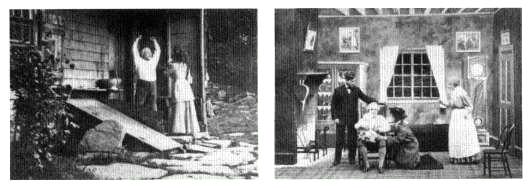
The Miller's Daughter. The miller disowns his daughter,
but finally forgives her when she presents him with a grandchild.
religious connection explicit). Living in city slums, "Hazel now realizes the full meaning of her disgrace" as she suffers the meager existence of the working poor. Exposed to the realities of class society, she is left destitute after her sole source of livelihood, a sewing machine, is repossessed. In despair, she returns to her father, pleading for forgiveness, which is again refused. It is Rodney, her once spurned but honest suitor, who rescues her from attempted suicide in the millrace. Through his act of courage, they are united and create their own family. The old miller's earlier judgment of Rodney has been confirmed and his wishes finally recognized, paving the way to a reconciliation with his daughter. The family, once fragmented, is reunited and linked to the next generation with the birth of a child. God, family, and country triumph over city, class society, and duplicity.
This film adaptation is unusual in many respects. For instance, there is a brief mention in MacKaye's Hazel Kirke that Carringford is going to give Hazel a drawing lesson, providing a cue for the reconceived character. In Porter's film the father-miller becomes the moral center of the film, whereas it is Hazel who best understands her own interests in the play. In Hazel Kirke it is Dunstan who misjudges Carringford and refuses to acknowledge his daughter's love and happiness until it is almost too late. In Porter's adaptation, Hazel is fooled by Carringford. She must learn the role of dutiful daughter, wife, and mother. The father assumes a godlike role. The change in title from the woman's name to her designated relationship to her father corresponds to this essential repositioning. It also suggests the extent to which the film industry at this time continued to be a male-privileging institution in comparison to the theater.
This screen adaptation shares many parallels with Porter's adaptation of The Ex-Convict . The mechanism for family reconciliation—the child—is a Porteresque touch. Porter also reverts to melodramatic, good-versus-evil stereotypes, but increases the realism by making the characters ordinary people, film-
ing on location and avoiding the pastoralism of MacKaye's play. Many offstage occurrences are shown in the Porter film, including Hazel's suicidal jump and her rescue. Class differences are banished from rural life (Rodney is just an average farmer) and located in the city. The portrayed conflict between small-town America and large-scale capitalism articulated the beliefs and fears of many native-born Americans. It reflected not only Porter's early experiences but the major demographic shifts of the 1880s and 1890s that had pushed Americans, including Porter and Griffith, out of small towns and into the metropolitan centers. The poverty of the urban slums, the conspicuous consumption of the wealthy, the antagonisms between classes, and the apparent corruption of local government deeply distressed city dwellers who recalled a romanticized and untroubled small-town childhood. Correspondingly, those still living in rural areas feared for a future shaped by distant, urban forces.
The opposition between rural and urban America provided the framework for a modest chase comedy, Down on the Farm , which Porter shot in October 1905, immediately after the completion of The Miller's Daughter . A group of boarding school girls, daughters of wealthy urbanites, steal apples from a farmer. The farmer chases them across fields and over fences (in a reversal of the women chasing the French nobleman in Biograph's Personal ) until they turn on the exhausted rube, throw him into the lake, and pelt him with apples. The country is clearly at the mercy of the city.
Edison films consistently highlight the city-country opposition. The rube or Uncle Josh character who comes to the city and is puzzled and overwhelmed by urban life is a theme Porter absorbed from the self-confidently urban culture of newspapers and vaudeville. From Another Job for the Undertaker (1901) to Down on the Farm and Stage Struck (July-August 1907), his comedies lampoon the country as unsophisticated and old-fashioned, whereas the dramas, derived from a romantic-realist tradition, usually idealize the countryside and criticize city life. The Ex-Convict and The Kleptomaniac focus on impersonal social and legal injustices of the city, while The "White Caps " shows a much more intimate community, where transgressions are punished quickly, surely, and pointedly. The conflicting views of city and country in Porter's dramas and comedies, which would be given more elaborate expression in the films of Griffith (The Country Doctor , 1909) and Mack Sennett (Tillie's Punctured Romance , 1914), reflect the transformations and conflicts in American life, particularly in a middle class torn between the traditional values and certainties of an increasingly outmoded way of life and the sophistication, convenience, and higher living standards of economically advanced urban centers. It was the middle class whose members contributed most extensively to American cultural life and articulated this conflict in particularly intense form.
The police, as representatives of the state, are a presence in many of Porter's films. The state and the family work hand in hand when constituted society is confronted by outsiders. But when Porter looks at the difficulties of urban life,
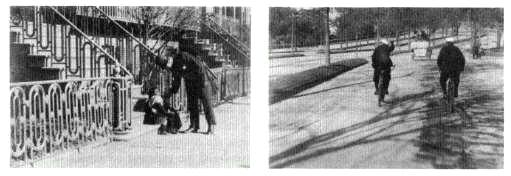
Life of an American Policeman: helping a child lost in the large, impersonal city (a scene appearing in
both versions) and chasing a speeding, wealthy motorist who has almost run over a child (in neither
version but available for separate purchase).
the police and the state often assume more complex roles. Porter's Life of an American Policeman is a sympathetic portrait of the agents of the law. Photographed with the cooperation of the New York Police Department in the fall of 1905, the subject was first shown at two vaudeville benefits for the Police Relief Fund in early December.[21]
Porter focuses on the daily routine of policemen without reference to their superiors, the higher courts, or the larger system of justice of which they are but a part. The emphasis is on good deeds and the ways in which the police benefit the community in which they live. The opening scene, which presents a policeman at home with his wife and child, identifies the police with the institution of the family. The policeman's role in maintaining community values in the impersonal city is shown when policemen help a lost child and rescue a would-be suicide from the river. Their courage is demonstrated as one policeman controls a runaway horse and others risk their lives capturing a desperate burglar. The latter scene, also sold separately as Desperate Encounter Between Burglar and Police , reenacts a robbery and the killing of a policeman as he tries to make the arrest. The actual incident took place on Manhattan's Upper East Side on the morning of March 20, 1904. News reports reveal significant discrepancies between the film sequence and what probably occurred,[22] suggesting that the film exaggerates the heroic actions of the police and the cowardice of the burglar.
In the film's last scene, a cop takes an unscheduled rest period, then skillfully circumvents the roundsman—emphasizing the policeman's humanity by showing his petty foibles in the context of real courage.[23] The film, a portrait of common people, avoids grandiose heroics that would reduce it to simple propaganda. Of all Porter's films, Life of an American Policeman comes closest to fulfilling the demands of nineteenth-century realism.[24] The focus on common
people, the portrayal of real situations (even to the point of returning to the original location and using actual participants to recreate the event), the refusal to subject the film to a single narrative, and the inclusion of the home life all make this a remarkable film.
From an editorial standpoint, the tension between the individual shot, the various sequences, and different possible programs is particularly striking in the case of Life of an American Policeman , with its 1,000-foot, full-reel length. Yet Porter in fact had 1,500 feet of usable subject matter, composed of nine discrete sequences. To solve this problem Porter (or the Edison Company) made two different 1,000-foot versions—one with "Desperate Encounter Between Burglar and Police" and the other with "River Tragedy," a sequence in which the police rescue a woman who has jumped into the Hudson. Bicycle Police Chasing Auto was in neither version but only sold separately. In addition several of the sequences appearing in the features were offered for sale as individual shorts. The subject reveals a conflict between one single order (the "preferred" version that included "River Tragedy") and possible alternative orderings, either the producer's alternate version or others that renters or exhibitors could create themselves. Thus Life of an American Policeman is an open or reversible text. Even within sequences like "Desperate Encounter between Burglar and Police," shots were conceived as discrete units linked together by overlapping action and temporality. Although Porter had largely, though not exclusively, assumed the role of editor, he continued to work under the strong influence of exhibitor-dominated cinema. The product lacked standardization. Porter's freedom to work in this way would, however, rapidly be curtailed by the demands of the nickelodeon era that was just beginning. The 1,000-foot restriction on a picture's length was already an industry standard, creating problems that Porter would seek to avoid in the future. On one hand, Life of an American Policeman can be considered Porter's last film of the pre-nickelodeon era; on the other, it already reflected the transition to this new exhibition form.
The Ex-Convict, The Kleptomaniac, Life of an American Policeman, The Miller's Daughter , and The "White Caps " offer an elaborate view of American life that acknowledges important social issues yet yearns for the simple solutions that once seemed so effective in the small-town environment out of which Porter had originally come. The films express the same middle-class concerns that the Progressive movement spoke to on a political level. The middle class was itself in transition: the old middle class that was outside the labor-capital dialectic was rapidly giving way to a new middle class that was part of this dialectic, shading into the working class at one end and the large capital-owning class at the other. Given the heterogeneity of the American middle classes, the political movement that they produced was predictably far from unified in its programs and in its alliances with other social groups. Porter's films best articulate the views of the older, more rural middle class—the petite bourgeoisie
whose members were neither employers nor employees. The political radicalism of specific films, when viewed in a larger context, had an underlying conservative basis. They articulated an angry response to a loss of power as government and the socioeconomic system became less responsive to this group's expectations and needs. Vigilantism of a certain sort became emotionally, if not intellectually, attractive.
Porter's subject matter and treatment differed substantially from the films being made by other American production companies. Biograph leaned toward comparatively sophisticated sexual comedies, such as Personal . Love triangles with clear references to infidelity, often involving a pretty "typewriter," were common in headliners like The Story the Biograph Told . Porter rarely dealt with sexuality in this way, and then only when imitating previous successes. Biograph subjects consistently offered entertainment rather than moralism. Its films celebrated the urban culture on which they were based—lampooning the city man who moves to the suburbs in The Suburbanite (October 1904) or summers in the rural countryside in The Summer Boarders (July 1905). Biograph dramas, moreover, commonly saw the country as a source of poverty and violence (A Kentucky Feud , 1905).
J. Stuart Blackton and Albert E. Smith, the two English-born producers of the Vitagraph trio, were also anxious to portray the excitement and dynamism of the city, to valorize the speed and mobility of the automobile. In Vitagraph's The 100 to One Shot; or, A Run of Luck (1906), a young man goes to the city, where he stumbles onto a hot tip at a race track and wins the money needed to save his family home from foreclosure. In a Porter film, gambling would never provide the means to salvation; but for Blackton and Smith, urban culture, even its more sinful manifestations, was a fount of opportunity and good fortune. Even Vitagraph's A Midwinter Night's Dream (1906), about a waif who dreams he is taken into the home of a wealthy family, owes much more to a sentimentalism derived from Charles Dickens than to contemporary American concerns.
The German-Jewish immigrant Sigmund Lubin was content to entertain moving picture audiences with comedies based on his competitors' successes (A Dog Lost, Strayed or Stolen; I. B. Dam and the Whole Dam Family; Meet Me at the Fountain ), fight reproductions, and films of crime (Highway Robbery, The Counterfeiters ). William C. Paley and William Steiner with Avenging a Crime; or, Burned at the Stake as well as William Selig with Tracked by Bloodhounds also featured violent confrontations. Many Selig films, however, used Colorado as a background for their dramas, increasingly romanticizing the frontier rather than the city. Porter's films aside, the exploration of social issues on the screen was primarily a European phenomenon, with Pathé's The Strike (La Grève , 1904), Scenes of a Convict's Life (Au Bagne , 1905), Le Cuirassé Potemkine (1905), and Mining District (Au Pays Noir , 1905) providing a few surviving
examples. Porter was the only filmmaker directly to confront American social concerns during this period.
Society and Its Outcasts
Not all Porter/Edison films from this period explored conflicts within the social structure. The staples of the industry in the pre-Griffith period, as today, concentrated on dramatic conflict between constituted society and those living on its fringes or completely outside it. The tramp, a frequent subject of Edison comedies, was one of society's outcasts. While Porter was growing up, tramps were customarily seen as a dangerous menace. As a result of an attempt to control their pilfering, many ended up in the Connellsville town jail.[25] Almost twenty years later, the tramp and his relationship to society were often viewed in more romantic terms.
The nearer these refugees from modern society can approach the habits of their primeval ancestors the greater appears to be their satisfaction. Many of them boast not only that they no longer need to work, but that they can live without begging. They tell you they are perfectly independent of the laws which govern the rest of the world.
. . . Is stealing to the man or boy who has abandoned human society for that of nature a crime? Stealing is the first law of nature by which all animals not subdued by man and all plant life obtain subsistence.[26]
This perception of the tramp's predicament begins to explain his status as the single most popular figure in turn-of-the-century culture. In "Happy Hooligan," "Burglar Bill," "Weary Willie," and dozens of other comic strips, plays, and short films, the tramp is generally portrayed as an annoying, but relatively harmless, scavenger, whose petty thievings and inevitable punishment provide numerous situations for comedy. The ritual beatings he receives at the hands of the law or outraged citizenry humorously define proper society's boundaries in terms of the outcast. They conform to Henri Bergson's assertion that the comic lies in an individual's inability to adapt to society, and that comedy functions as a kind of social ragging.
The Burglar's Slide for Life (March 1905) elaborates on Porter's earlier Pie, Tramp and the Bulldog (1901) as the bulldog protects the home. He is man's (socialized man's) best friend. The tramp burglar, looking for a free lunch, prowls an apartment building. He hides in a vapor bath when the mistress of the house enters the room. Porter's familiar overlapping action is used as the tramp is discovered, flees through a window, and is chased down the clothesline by the family dog (Mannie). In his desperate effort to escape, the fleeing burglar thus mimes a then popular daredevil stunt ("the slide for life"). Reaching the courtyard, he is beaten by other apartment dwellers and bitten by the dog.
The tramp avoids his ritual beating in Poor Algy! (September 1905) by
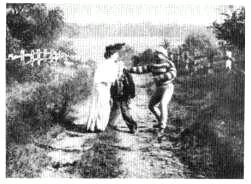
Poor Algy has in error received the
tramp's customary punishment.
switching clothes with the young lover, Algy. When Algy, dressed as a tramp, tries to approach his girl, she fails to recognize him and retreats. Algy chases after her. The girl soon passes a pugilist doing roadwork for an upcoming fight. He administers the tramp's traditional beating—to poor Algy. Once again Porter played with a well-established genre and its codified relationships between characters: minimal variations gave the piece a freshness not always apparent to present-day viewers.
"Raffles "—the Dog (June 1905) was another Edison comedy involving a thief. The original Raffles started out as a series of short stories by E. W. Hornung about a gentleman safecracker of elderly years who wins readers' amused tolerance more than their condemnation.[27] By June 1905 Raffles had been made into a play and a comic strip. In "Raffles "—the Dog , "Raffles," once again played by Mannie, is a charming, innocent thief directed by conniving masters. After the thieves rob several upright citizens, a chase ensues that concludes with their capture. The dog's asocial behavior is like that of other petty thieves in Edison comedies: the tramps in Poor Algy! and The Burglar's Slide for Life , the juvenile delinquents in The Terrible Kids (1906), and the shiftless "darkies" of The Watermelon Patch (1905).
Porter, like other filmmakers of the pre-1908 period, often portrayed outlaws who threaten society as members of fringe or outcast groups, with such characterization serving as motivation for their illegal activities. This is the case with the racial humor and black stereotyping in Porter and McCutcheon's The Watermelon Patch (October 1905). Their happy-go-lucky thieves, who "seem to think eating watermelon is the only pleasure in the world"[28] are comedic counterparts to the ruthless, scheming lovers of white women in The Clansman. The Watermelon Patch begins as an absurdist comedy: a number of "darkies" steal watermelons and flee, pursued by redneck farmers dressed in skeleton costumes. Losing their pursuers, the darkies reach their destination, where they dance and
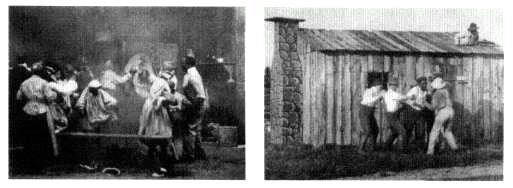
The Watermelon Patch. Inside and outside: spatial distortions reduce fun-loving "darkies" to pygmies.
enjoy their watermelon until the rednecks arrive. When the whites board up the exits and seal the chimney, the darkies are soon covered with soot, another racial "joke." (In 1905 many Negro performers still went on stage in black face—as did white actors impersonating blacks. This joke played with the "childish" belief that black skin is black because it is covered with soot.)
In the film's last three shots, Porter alternated exterior and interior scenes using an editorial construction similar to the ending of Life of an American Fireman . After showing the rednecks sealing the chimney, Porter cut to the interior, where the "darkies" hear the intruders, grow quiet, and slowly feel the ill-effects of the smoke. Realizing what is happening, they make their escape. The final shot, once again of the exterior, returns to the moment when the darkies begin to make their escape. It shows them coming out of the house and receiving the blows of the amused rednecks. What is fascinating, both cinematically and perhaps as an example of unconscious racism, is the contrast between the exterior scenes in which the handful of rednecks dwarf the tiny shack and the interior scenes in which the shack comfortably holds twenty "darkies"—reducing them to the size of pygmies.
The Watermelon Patch is as revealing of the state of American cinema in 1905 as it is of American racism. Earlier Edison films depicting African Americans include Chicken Thieves (1897), in which "darkies" raid a chicken coop; Watermelon Eating Contest (1896), a one-shot facial expression film of happy blacks eating watermelon; and The Pickaninnies (1894), showing three Negro youths doing a jig and breakdown. These often-used motifs are integrated into Porter's later film. The dancing and watermelon contest are treated as self-contained scenes, which interrupt the Watermelon Patch narrative. The isolated images of blacks presented in these earlier films are unified and elaborated.
They are superstitious, petty thieves, good dancers, and love watermelon. They like to have a good time, but their inherent laziness must be subsidized by pilfering.[29]
The Watermelon Patch owes much to Biograph's The Chicken Thief (1904), in which darkies steal chickens and bring them home for a party of eating and dancing. On their next outing, the two thieves are chased and caught by angry rednecks.[30] The many parallels between the two films are partially explained by McCutcheon's involvement in both projects. Sigmund Lubin's somewhat later Fun on the Farm (November 1905) makes the lighthearted tone of these two films even more explicit: tarring and leathering the local pumpkin(!) thief is shown to be one of the many amusing ways to pass the time down on the farm. In all these films, whites chasing blacks is shown to be good, clean fun. African Americans are portrayed as childlike and unsocialized. Whites, as responsible members of society, are obliged to chastise them and maintain discipline.
Although many early films (comedies as well as dramas) used made-up whites to play the roles of blacks, the Edison Company assured prospective buyers of The Watermelon Patch that "all the watermelon thieves are genuine negroes."[31] Not surprisingly, this and most other motion pictures did not make a "sure hit" in the black communities. As storefront theaters began to appear across the country in late 1905 and 1906, those intended for black audiences were among the few to fail. According to one amusement manager, "When a negro goes to a show, it pleases him most to see black faces in the performance. But no pictures are made with Senegambian [sic ] faces."[32] The few films that did use black performers must have alienated these audiences even more.
While those outside proper society are undersocialized in Edison comedies; outsiders in Edison dramas are antisocial. They threaten society's very fabric, often by directing their attacks against the family. In Stolen by Gypsies (July 1905), gypsies abduct a well-to-do family's child, who has been left momentarily unattended by a nursemaid. This film belongs to a popular kidnapping genre that emerged in 1904. Porter's first effort was the three-shot Weary Willie Kidnaps a Child (May 1904), but the genre was made popular by such English imports as The Child Stealers (1904).[33] Illustrious examples of this family-centered genre eventually included Cecil Hepworth's Rescued by Rover (1905) and D. W. Griffith's directorial debut, The Adventures of Dollie (1908). All have remarkably similar narratives. A gypsy or some other outcast steals and then abuses the young child of a respectable, upper-middle-class family. The parents experience a range of emotions—anguish, guilt, remorse—over their loss. As in Stolen by Gypsies , the situation is usually more poignant because the victim is an only child. In the inevitable happy ending, the child is rescued and the nuclear family restored.
By October 1904 the genre was well enough established for Biograph to turn
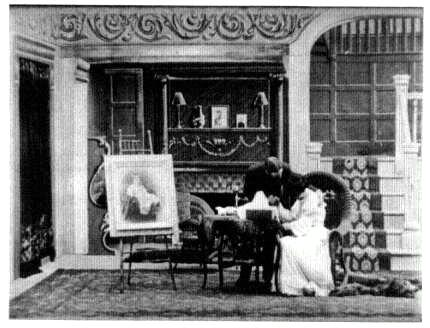
In Stolen By Gypsies, parents mourn the loss of their only child,
whose portrait dominates their home.
it inside out and make a comedy, The Lost Child . When the child disappears into a dog house, the mother assumes the worst and chases an innocent passerby, whom she believes to be the kidnapper. Societal paranoia and the family-centered drama are spoofed, although the irony is softened because the generic form defines it as an amusing exception. For the first half of Stolen by Gypsies , Porter and co-director Wallace McCutcheon, who had been partially responsible for The Lost Child , took the popular Biograph success and gave it another twist. As before, the wrong people are chased. They are no longer innocent pedestrians, however, but chicken thieves. Moreover, the child is actually stolen. Although sometimes humorous, the first part emphasizes the vulnerability of the family to assault. The second returns to the conventional formula: the child is found and reclaimed by the parents, reuniting the family, while the police perform the subsidiary function of backing up their action with force.
Porter considered Stolen by Gypsies an important film and sent the following note to West Orange with the undeveloped negative:
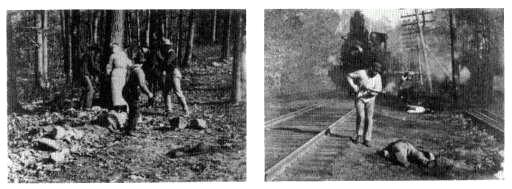
The Train Wreckers. The outlaws capture the switchman's
daughter; later her lover, the engineer, kills her tormentors.
July 6th
Dear Sir:
Am sending you today undeveloped negative complete with announcements of "Stolen by Gypsies". Have made tests of same and found them photographically perfect. In as much as this has been a quite expensive production kindly see that every care is taken with them. Have instructed Mr. Bonine to develop them in "Pyro."
Very truly yours,
E. S. Porter
P.S. Please return negative to me after they are developed and I will trim same and forward to you immediately.[34]
Stolen by Gypsies , shown with Edwin Arden's play Zorah at Proctor's 5th Avenue Theater, was lauded by the New York Sun . The review was promptly reprinted in an Edison ad:
Yesterday between the second and third acts there was a wait of over half an hour, during which the audience was treated to an intensely interesting motion picture drama, entitled "Stolen by Gypsies." There was so much human interest in this little story and its climaxes came so thick and fast, as it followed the child from the moment that it was stolen up to the hour of its rescue a year later in the gypsies' camp that it made "Zorah" by comparison seem rather stilted and stagy.[35]
Despite the praise, the feature sold a modest 59 prints over the next year and a half (compared to the more than 300 copies sold of Hepworth's Rescued by Rover , which was released in the United States at about the same time).
The Train Wreckers (November 1905) includes Porter's most violent expression of the conflict between constituted society and its outsiders. The outlaw band, with its apparently irrational desire to destroy all social order, is finally eliminated by a combined force of railroad personnel and select passengers.
From the Lumières' Train Entering a Station (1895) to Ilya Trauberg's China Express (1929), the train is one of the central iconographic figures in silent cinema, and Porter, perhaps more than anyone, made it so. Trauberg's train is divided into first, second, and third class compartments, with the principal conflict between the workers in third class and the imperialists and their Chinese associates in first. Porter's train has no such differentiation. Although the film's principal characters are skilled members of the working class, the conflict is not between classes or different social groups, but against an external threat, a cause around which society can rally all its members. With order finally restored, a romance between the engineer and the switchman's daughter, introduced at the beginning of the film, resumes. Society is able to return to its proper preoccupations.
The Train Wreckers effectively demonstrates the need for social cohesion in a way that could serve as a prototype for future good-guy-versus-bad-guy conflicts. It was extremely successful, selling 157 prints during 1905-6, and its narrative would be reworked six years later in one of D. W. Griffith's most successful Biograph films, The Girl and Her Trust (released March 28, 1912). Films like The Train Wreckers and Stolen by Gypsies see the social order as continually threatened from without. In articulating this conflict, Porter used the chase as a central narrative strategy: the bulldog chases the tramp down the clotheslines; the rednecks pursue the watermelon thieves; the railroad passengers overtake the train wreckers; and constituted society defeats its enemies. In films where Porter examined the inner workings of society, this is much less likely to be the case.
The Edison Comedies
Although Porter took serious looks at American society, comedies were the mainstay of Edison production. Generally they worked within well-defined genres, like Poor Algy! and The Burglar's Slide for Life , or adapted narratives from fads and hit songs that had wide audience recognition. Many completely avoided any reference to societal concerns. Porter made one technical breakthrough that elevated several of his comedies from this period to the status of "novelties": it was a special form of object animation. As Porter applied the technique, a hodgepodge of letters moved against their black backgrounds until they formed the intertitles for the succeeding scene.[36] This was done for How Jones Lost His Roll (March 1905), The Whole Dam Family and the Dam Dog (May 1905), Coney Island at Night (June 1905), and Everybody Works but Father (November 1905).
When Edison's advertising manager, L. C. McChesney, sent out copy for How Jones Lost His Roll , he did not find it necessary to mention the film's narrative.

Postcard art was the source for The Whole Dam Family and the Dam Dog.
This film has already created a decided sensation in numerous Vaudeville Theatres, Moving Picture Entertainments, and among Exhibitors both in this country and abroad. There is not a dull or uninteresting moment throughout the entire picture while at several points the audience breaks into rounds of applause and laughter. From beginning to end the audience is kept in one continual state of expectancy. The illustrations which are reproduced from the film itself show "HOW JONES LOST HIS ROLL ," while the letters after much effort and manoeuvering disentangle themselves at intervals and tell the story in words. . . . Everyone wants to know how it is done.[37]
The story, about Jones who is systematically cheated of his money by a so-called friend, is told twice, in words and pictures, with the "jumble announcements" making the intertitles more important than the pictures they illuminate, inverting the normal relationship between image and title.
The humorous subversion of conventional narrative strategies was also an important aspect of The Whole Dam Family and the Dam Dog . Many films of this period (Biograph's The Firebug , Vitagraph's The Servant Girl Problem , and Edison's How a French Nobleman Got a Wife . . .) are introduced by a close-up of the main character(s) "so that his make-up, costume . . ., facial expression and bearing may be appreciated by the audience."[38] Sometimes, as with Biograph's The Widow and the Only Man , name cards at the bottom of the frame identify the individual. In The Whole Dam Family and the Dam Dog , each family member is introduced with a close-up and a name card—"Mr. I. B. Dam," "Miss U. B. Dam," and so on—at the bottom of the frame. These are followed by an abbreviated one-scene narrative as the Dam dog (Mannie) interrupts a family meal by pulling the tablecloth and all the dishes onto the floor. As Tom Gunning points out, the normal relationship between the introduction of characters and the development of narrative is reversed. Not only wordplay but playing with the audience's expectations of cinematic form contributed to the comedy's humor.
Edison advertising announced that The Whole Dam Family and the Dam Dog continued "a popular fad which has been widely advertised by lithographs and souvenir mailing cards and has recently been made the subject of a sketch in a New York Vaudeville Theatre."[39] Production records indicate that this film
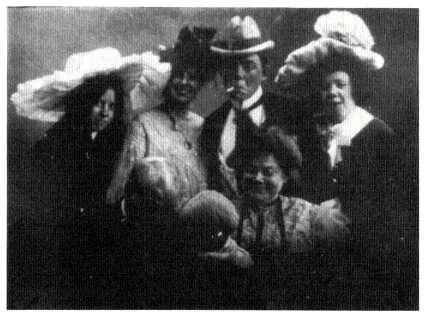
The Whole Dam Family and the Dam Dog: a family portrait.
was shot in late May 1905, a month before the theatrical production had its debut at the Aerial Gardens in New York.[40] The Edison film was not indebted to the theatrical production for its conception; publicity merely referred to it as a general indication of the subject's timeliness and popularity. Rather it took the postcard caricatures and realized them in a series of facial expression "films." A group portrait follows, formally reprising the family panorama on the postcard. The dog's initial appearance in the final, narrative segment remains consistent with a left-to-right reading of the postcard as well as its place outside the enveloping dark background. If the subject was familiar, the company claimed to have used its "usual up-to-date methods" to illustrate "this popular subject in a most novel and original way." Narratization that gave new and special meaning to the designation of the family pet as "the Dam dog," the Edison dog itself, animated titles, and close-ups: all brought original elements to a popular fad, enabling Edison to sell 136 copies of the film during 1905-6. On the eve of the nickelodeon era, this combination of novelty and familiarity was the formula for commercial success.
Everybody Works but Father (November 1905) "opens with a laughable 'Jumble' Announcement—a new feature, exclusively Edison, mysterious and novel to a degree."[41] Its narrative was based on a song of the same title popularized by Lew Dockstader. Biograph had already made a similar film a month earlier, but without the animated intertitles. The Biograph film was advertised
as "a decided novelty for Illustrated Song Singers," and a surviving program urged the audience to join in the chorus, a strategy of exhibition not suggested in Edison promotional material.[42] Another Edison animated title from this period survives in the George Kleine Collection at the Library of Congress. This fragment reads "23 Skidoo," but has no accompanying picture. In any case, the Edison Company must have felt that the novelty of animated titles had been exhausted. Perhaps because Everybody Works but Father sold only forty-seven copies in the fifteen months after its release, the procedure was abandoned. J. Stuart Blackton, in contrast, soon applied the technique to new situations when he animated his sketches in Humorous Phases of Funny Faces (April 1906) and various stuffed animals in A Midwinter Night's Dream (December 1906). Porter was one of the first filmmakers to use animation techniques, but others were to see their broader possibilities.
Porter and his contemporaries frequently turned hit songs into comedies. In May 1905, a few months before making Everybody Works but Father , Porter photographed On a Good Old Five Cent Trolley Ride . This "burlesque on street car service"[43] was based on a song of the same title with the following chorus.
When speeding along on the trolley
I feel like a big millionaire.
A ride on the Trolley is jolly,
Whatever you give up is fare.
The Trolley's a hummer in summer
If you've got a girl at your side.
To tease in the breeze while you're stealing a squeeze,
On a good old five cent trolley ride.[44]
The Kinetograph Department suggested that "it greatly adds to the effectiveness of the picture if the music of the well-known popular song 'On a Good Old 5¢ Trolley Ride' is played while the picture is shown. The words and music of a portion of the chorus complete the picture."[45]
The Little Train Robbery (August 1905) was indebted to another well-known hit-this time in cinema. Porter burlesqued his own The Great Train Robbery by substituting children for adults and using a miniature railroad and playhouse as sets. The young robbers don't take money but candy and dolls. Their getaway replicates the escape in The Great Train Robbery , except that the delinquents are finally captured by full-grown policemen. The bandit queen who has organized the robbery, however, escapes. The film's stance was intended to be nostalgic. The Edison Company hoped that "while the young folks are enjoying themselves their elders can find equal enjoyment in recalling their own youthful days, when their highest ambition was to become a 'Jesse James,' or a 'Bandit Queen.' "[46] The film was nostalgic for another reason. Porter made the film at Olympia Park while visiting his hometown of Connellsville.[47] Released as the nickelodeon era was beginning, The Little Train Robbery must have
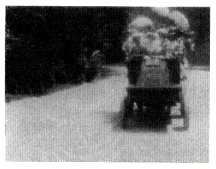
Boarding School Girls. The car wiggles down the road.
The scene suggested too much exuberance and was
removed.
disturbed literal-minded critics who saw storefront theaters as schools for crime. Such a film would have provided undesirable role models for the young. Even worse, it suggests that these children were modeling themselves on the bandits in a film "universally admitted to be the greatest production in MOTION PICTURES ." If the Kinetograph Department honestly expected the new film to "meet with the same unqualified approval and unprecedented success as The Great Train Robbery ,"[48] it was disappointed. The picture sold a meager thirty prints during 1905-6, when most of Porter's comedies sold two or three times that number.
Another Edison comedy, Boarding School Girls (July-August 1905), followed the students of Miss Knapp's Select School to Coney Island. As with Rube and Mandy at Coney Island (1903), the film enabled audiences to vicariously enjoy the famous resort through characters who were there on an outing. Although made only two years later, Boarding School Girls integrates narrative and spectacle, as well as performers and environment, in a much more seamless fashion. A remarkable traveling shot of the girls being driven to the amusement park, photographed from another moving vehicle, was removed after the first prints were made.[49] The scene can be found in the paper print version, but not in the otherwise complete negative at the Museum of Modern Art. Perhaps the playfulness appeared too dangerous (the car wiggles back and forth across the road) and bad for the school's image. Once the group arrives at the amusement park, "they take in everything in sight. Passing through Creation they capture the 'Miniature Railway' and 'shake' their governess who endeavors to overtake them. 'Shooting the Chutes,' 'Riding the Camels,' 'The Dew Drop,' 'Steeplechase' and 'Carousel' are all visited. A parade on the beach in bathing costumes is followed by a visit to the 'Flying Swings' and a dip in the surf. 'The Trolley,' 'Razzle Dazzle,' 'Moving Stairway,' 'The Twister' and 'Barrel of Love' are next visited in turn, until finally overtaken and captured by their governess they start for home."[50]
Another Porter comedy, produced in the fall or winter of 1905, was Minstrel Mishaps , which survives in the Kleine Collection at the Library of Congress. It was "conceived and produced by America's Only Minstrel Star, LEW
DOCKSTADER ,"[51] showing his "late arrival on the special, his dash to the theatre in the only cab in town, the great make-up scene, the minstrel band and the Biggest Knock-out Finish with Lew Dockstader himself in every scene." The film was toured as part of Dockstader's Minstrels in the spring of 1906 and "caused most laughter and applause."[52] By the end of 1907, Dockstader was selling the picture to film exchanges. A year later, the Edison Company bought the negative and sold the comedy as a regular release.
Actualities and Short Subjects
Although the production of narrative features had increased dramatically by early 1905, Edison cameramen continued to generate a diverse selection of films. Porter photographed news and sporting events like President Roosevelt's Inauguration (with Robert K. Bonine); Play Ball-Opening Day, NYC (April 1905), which showed the baseball game between John McGraw's New York Giants and the Boston Braves;[53]Opening of Belmont Park Race Course (May 1905); and Start of Ocean Race for Kaiser's Cup (May 1905). Spectacular Scenes—N.Y. City Fire (December 1905) showed "the destruction of the Lackawanna and Jersey Central Railroad Ferry Houses."[54]Scenes and Incidents, Russo-Japanese Peace Conference was photographed on August 8, 1905, in Portsmouth, New Hampshire—the setting for President Roosevelt's mediated settlement of the Russo-Japanese War. It offers an interesting case study in the production of newsworthy actuality subjects in 1905.
Scenes and Incidents, Russo-Japanese Peace Conference, Portsmouth, N.H . sold thirty-one copies, or 24,800 feet of film—almost 40 percent of Edison's actuality footage for 1905. It also provoked a court case. The story begins in mid July, when George H. Keyes of the Portsmouth Observation Company arranged for an Edison photographer to come to Portsmouth, New Hampshire. Porter arrived a week later and took a 220-foot subject of a dynamite explosion that widened the Piscataqua River. Total cost to Keyes:
220 feet negative @ 40¢ per foot | $88.00 |
220 feet positive @ 12¢ per foot | 26.40 |
Porter's expenses | 25.90 |
$140.30[55] |
The negative was held at the Edison lab and prints sold to Keyes. Keyes was eager to have Porter return the following week and film the ceremonies surrounding the Russian-Japanese Peace Conference. He thus brought the most popular news subject of 1905 to the Kinetograph Department's attention.
Once Edison executives were informed of the event, they decided that the subject should be marketed commercially rather than made for a commission. Moreover, the Kinetograph Department wanted an exclusive and so appeared to cooperate with Keyes without actually committing itself to his request. When
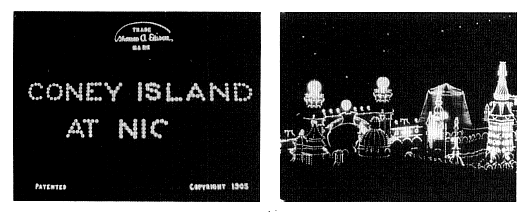
Porter complemented the fantasy world of lights that was Coney Island at night with animated titles.
Porter returned to Portsmouth on August 6th, Keyes learned that the cameraman would not be in his employ. Duped, Keyes angrily contacted the Biograph Company, which agreed to supply a motion picture photographer, who arrived the following day. Fortunately for Keyes and Biograph, but unfortunately for Porter, the ceremonies that had been scheduled for August 7th were delayed until August 8th.[56] Keyes now tried to turn the tables by initiating a suit against Edison, so that Porter's camera equipment was attached an hour before the festivities. Fast work enabled Porter to reach a bondsman, free his equipment, and still photograph the pageantry. Without Keyes, neither Edison nor Biograph would have filmed this historic event.
During 1905 the Kinetograph Department also produced a few human interest films like Steamboat Travel on the Long Island Sound (August 1905) and Firemen's Parade, Scranton, Pa . (September 1905).[57] Neither was considered important enough to copyright. Coney Island had been a favorite locale for this type of subject, and the Edison Manufacturing Company acquired "the exclusive privilege for the season of 1905 at Dreamland, one of the principal parks."[58] For Coney Island at Night (June 1905), Porter's camera caressed the lit-up amusement center with long sweeping pans, producing an eerie beauty. Other subjects made under this arrangement included Hippodrome Races, Dreamland, Coney Island (June 1905), Mystic Shriners' Day, Dreamland, Coney Island (July 1905), and June's Birthday Party (July 1905), as well as Boarding School Girls .
In June an Edison photographer took several short films in Bliss, Oklahoma, with Lucille Mulhall's Wild West Show. Such films as Lucille Mulhall Roping and Tying Steer, Great Buffalo Chase , and Western Bad Man Shooting Up Saloon sold between one and six prints.[59] Short comedies from 1905 included Unfortunate Policeman and Digesting a Joke . In the latter film comedian James T. Powers cuts out an amusing article from a paper, swallows it, and seems to
find its contents amusing as he digests it.[60] (None of these subjects were copyrighted, although descriptions can be found in Edison's July 1906 film catalog.) The Edison Company was able to offer many more short comedies by selling individual scenes from its longer films. In 1905-6, the company sold nine copies of "Burglar and Bulldog" from The Burglar's Slide for Life , eight copies of "Sneezing" from The Whole Dam Family and the Dam Dog , seven of "Girls and the Bumpety Bumps" from Boarding School Girls , and five of "Old Sweethearts" from The Seven Ages . This did not mean that Porter conceived of each scene as an independent film. The Kinetograph Department's sale of these separate scenes recognized that some exhibitors still wanted to purchase short subjects, even though such films could no longer be profitably produced for that purpose alone.
Miscellaneous subjects showed the sharpest decline in popularity and production. Among the handful to be photographed were Blowing Bottles and The Kilties Band : neither sold a single print. Sales figures and copyright practices make it clear that by 1905-6 all forms of motion picture production other than "feature"-length narrative films had become marginally profitable at best. The shift to longer story films was not a "choice" made by producers: it was a necessity determined by the tastes and demands of exhibitors and their audiences. Edison's variety approach to film production was in its final stages of decline as the nickelodeon era arrived; the rise of storefront theaters simply completed its demise.